|
Song
Dog Kennels
|
|
|
|
Home
of SONG DOG KENNELS -- Copyrighted Registry for the AMERICAN
INDIAN DOGS
|
THE AMERICAN INDIAN DOGS
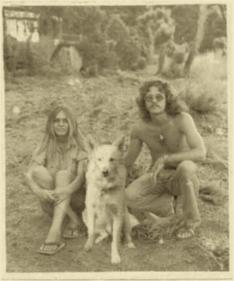
Kim
Laflamme {RIGHT}
BUFFALO
BILL {MIDDLE}
IS
ONE OF
THE FOUNDATION'S STUD DOGS OF THE
AMERICAN INDIAN DOGS, A FRIEND OF KIMS
{LEFT} 1960'S
|
Modern History of the American
Indian Dog No one will probably ever know exactly what types of Indian Dogs every Nation or Tribe had, unless they were there at the time. The old history books and story’s from explores are not accurate accounts, as they didn’t understand the entailed complex breeding that Native Americans passed down in their culture, as these explorers came from an entire deferent culture. More of a culture clash than understanding another culture. Unless they had actually talked with and studied the old ways with the Elders, that knew all the oral traditions and old breeding way’s. (for further studies on ‘The Old Breeding Ways’; see the “Myths and Misconceptions of the American Indian Dogs”). With the amount of years that have passed now, there aren’t any of the older Elders left who lived with The Dogs before the white man's dogs began mixing blood with them. But talking to the Elders and with years of research and study all the pieces begin to fit back together. My Great Grandmother was Blackfoot and Iroquois, and it is said that when she married my Great Grandfather she brought with her several dogs as her dowry down from the La Flamme River area in Canada. These were probably the old trap-line Indian Dogs, as they were the dogs from that area of Canada. These dogs are almost the same as the Common or Plains types. My Grandfather still had a few of the off spring of some of these dogs; I was fascinated with their versatility and loyalty. They were still being used for hunting, guarding, tracking and herding. My Grandfather said, “One good dog could do the work of a dozen men.” From the time I was a boy I talked to literally thousands of Elders about the dogs and tried to gather as much information as I could on them. I was amazed that the Native Americans had such amazing natural genetic and selective breeding skills to match or exceed any modern geneticist today. This ancient knowledge has been kept pretty much underground. Passed down by word of mouth from generation to generation, but it’s disappearing fast, like a lot of the Native culture. But there are lots of historians still here keeping 'The Red Road' and all the Old Knowledge intact and moving into the future. For our future generations and to help bring this planet back to a better balance than the “Fast Fix, disposable”, direction it’s headed. Keeping our old dogs healthy in mind and body is very important in that balance also, to in turn learn from them. modern man and the industrial age culture has caused us to lose a lot of those instincts that help us stay connected with nature and our earth, when he needs it most. … In all the Old Indian Nations from northern Canada to the tip of south America you could find these medium sized working dogs, they differed slightly depending on the geographical area, and what they were used and needed for in those areas. (For where these types where originally found see Old A.I.Dog Map (coming soon)). From all the research, pictures and accounts from native Americans themselves, it appears that the larger -types were found just in the far north and were mainly used for pulling, although they had a more collie like personality, and weren’t at all like the modern husky’s of today. Not only different personalitys but much smaller, larger ears, light eyes, curved tail (not curled), and much finer built than modern husky’s. Even the largest Malamute types, back 500 years before Europeans arrived and started crossing in their big dogs, and breeding them much bigger than their Indian dog ancestors, were never any larger than 75 lbs. The slightly smaller working-types were mainly found amongst the Plains groups, with a few exceptions. These medium-sized Common or Plains types were found with every Nation or group from the tip of South America up to Alaska, these were the all around working type dogs. These working medium sized dogs where always a natural sable coloring pattern, never with white spots or large white markings except on the chest and sometimes on the legs….. There were also smaller pug nosed dogs found here and there or wool dogs, long haired small sheep looking dogs, used for shearing and weaving their fur, and the hairless in South America used for heeling. But even these smaller types always had prick ears. A lot of trading went on from the Northern most American continent to South America, even back in The Dog Days and even more, after The Horse Days. Traded items such as tools, salt, pipestone, blankets, knowledge, ceremony’s, culture, pots, tools, people and later dogs and horses. This trading of dogs has been proven, as dogs indigenous to one area have been found in another, from one end of the continent to the other. Native Americans were very well versed in selective breeding, as can be seen by the way they bred and trained the (big-dogs) horses, when they arrived with the Spanish. In just a 50 year period of time from when horses first appeared on the north American continent, the Native Americans had become the best riders, trainers and breeders of horses in the world. There is also evidence of dogs used for very specific purposes, for their wool, spiritual ceremonys, heeling, herding, hunting, buried with the bodies to help the dead in the after life, keeping owners warm at night, tracking; small game, turkeys, deer, buffalo and even fish. So it is very obvious that Native Americans understood selective breeding and even the gelding of most male dogs to prevent unwanted breeding and keeping only the proven best for breeding, going back thousands of years. I believe, through all of my research, studies in dog behavior and learning about each individual type (or breed) in it’s respective area, genetic studies, accounts of Spanish Priests, Soldiers, explorers, trappers and especially talking with, and learning from the Elders about 'the Old Ways',….or their (recipe) for selectively breeding, to keep that balance of all the particular types, to perfect that balance, for the perfect combination that creates 'The Mix' (or Plains Indian Dog Breed). These Elders, claimed that the largest population of the Indian Dogs were found in the Plains areas. One early explorer noted that there were over 300,000 of these dogs just amongst the Plains Indian Groups…. In my opinion, breeding all the various tribal dogs together is doing the same thing that was done hundreds and thousands of years ago, by these expert breeders. This makes the Plains Indian Dog the melting pot of all the working type Dogs from the north, south, east, and west. Plus any new migrating groups of these new people’s dogs that might have added to the mix. These dogs were in turn traded back to the Plains Indian breeders and then traded back again with those added bloodlines. The earliest accounts and observations of Indian Dogs say, “they looked like a cross between a fox and a wolf”. These early explorers had probably never seen a coyote or jackal, or I’m sure they would have thought that’s what the dogs looked like. They also claimed they saw the Indian Dogs running wild in different areas. I believe these were either coyotes, feral Indian Dogs or both. One account felt that the Indians Dogs were a jackal/coyote derivative or cross and these wild animals followed the aboriginals around. Coming from an entirely different invading prejudice culture they couldn’t have been more wrong, as these were highly trained and selectively bred dogs bred by very naturally instinctual breeders. The American Indian Dogs did and do have a more primitive, natural jackal and coyote appearance, that are very similar looking to each other and very closely related. They are the more evolutionary, advanced survivors of the canine world, finding that symbiotic relationship with man much easier than the older further behind on the evolutionary scale and bigger wolf. Plus all the Elders I interviewed had information passed down to them that The Old Ones used to cross in Coyote every so many generations. (see page on “Myths and Misconceptions on A.I.Dogs” on this web site). According to new studies, and it’s always been my opinion also;… all dogs from all over the world where originally developed from Jackals and Coyotes or the Asian wolf, (more jackal than wolf) and isn’t actually a wolf at all but, like the Red wolf here, is more coyote than wolf. These later became in some areas the more domesticated Dingo type, one of the more primitive type dogs that were trapped in Australia and also brought by different migrating groups into the America’s from the south. Also later the Vikings brought in their working herding collie types back 3,000 to 2,000 years before the big European onslaught, into the pre-Columbian America’s 500 years ago. These were ancestors of the Icelandic shepherds of today, that had been taken in the more herding direction and the Inuit dogs in the more pulling direction and where mixed into the Hare Indian dog of the northeastern U.S. Because of my interest and knowledge of The Dogs, and my endless questions, some of the Elders asked me to be the guardian of The Dogs and sent me to study with the Old Ones that knew the Old Ways. They said it must be a responsibility, left to me, as every Nation used to have their genetic expert breeders and this information was passed down from generation to generation. My quest had begun! I started with 2 dogs, brother and sister, these where Plains, Common and or Hare Indian Dogs. I looked around for more Dogs, believing at the time, there must be lots more. I wrote to every reservation or Native American organization from Canada to Mexico. I gathered all the articles, books and information I could find. Always talking to the Elders to learn what the dogs looked like from the deferent area’s. I heard from a Mohegan family who had 4 of their Dogs, 2 were fixed and old, 1 adult female and 1 puppy. They wouldn’t sell them, but offered to let me breed from them, this was impossible, as I was only 14 at the time. I contacted these same people years later, but all their dogs had died except for one male puppy that I used in the breeding program. They had sent me pictures and they looked just like my dogs and were a silver-sable color, I later found some more of these same types and believe them to be of the Hare Indian Dog type. I also heard from an Elder from a Southern Reservation who raised sheep in Arizona and he had what he called a half-breed Indian Dog, which was an Indian dog that had been crossed with the Old Spanish or Bask- sheep dogs. The Indian ranchers of that area called them half-breeds, the White ranchers called them Australian Shepherds; (To learn more about where the Australian Shepherd breed REALLY came from, read my article on “Myths and Misconceptions on Am., Indian Dogs”). These were the foundation lines of the Australian shepherds, who’s origins have been lost, or hidden through the years. But he new of some feral Indian Dogs living in the Canyon De Chilly area, the unaware Ranchers there were killing them, for they were getting their livestock, they called them Black Devil Dogs. With the help of a friend and teacher we went searching for these Dogs, we contacted the locale SPCA, who new of these dogs. They had one earlier, but they had put it down, but told us where to find them, and they would call me if or when they found another, which they did later on. We camped out observing the dogs and eventually trapped 2, a male and female, both black. Because he was older, the male turned out to be very wild and un-trainable, but at least I did use him in my breeding program. The female was bred to my male Hare Indian Dog. I then found a dog in Canada that was said to be from the Ojibwa, and or Chippewa, it seemed to be very similar or a combination of Trap-line Dogs and Village Indian Dog. This female was then bred to my male Pueblo, and their pups bred to my female Hare. I then found another Village Indian Dog from a sled dog racer, that used them for long distance racing, he said they would work tell they dropped for him, if he wanted them to, and could beat anything. I then bred this Village Indian dog to my dogs and their perspective pups. These northern dogs I knew where Indian dogs as they were very collie like and not husky like in their personality, conformation, larger ears..etc... Today the Village Indian Dogs are pretty much assimilated within the Alaskan husky breed. You can still see a few long distance endurance racers that carry some of the old Indian dog blood. But now these Alaskan husky’s are now being bred into the new “designer” sled dogs. I then bred this Village Indian Dog to my Dogs and their respective pups. I was then drafted into the army and had to leave my Dogs with family and friends. After the Viet Nam War mess and after finally getting out of the Army……. I traveled, from Res., to Res., from Canada to Mexico, studying and finding out more about The Camp Dogs, fallowing every rumor I heard. I found some more Village and Trap-line Dogs in Canada, and 2 very strange Tahltan Bear Dogs (1 solid black with some white and 1 choc. Red) they looked like some kind of spits-terrier. Smaller than all the other Northern type Dogs, but very similar to the smaller Pueblo dogs of the southwest,;…new research shows that the Tahltan Indians are actuality related to the southwestern Indians and traded dogs back and forth for thousands of years. ; (for more info., on this north south connection, and the Tahltan Indian dogs, read “Myths and Misconceptions on Am., Indian Dogs”). Later I saw some New Guinea Singing Dogs that looked and sounded very similar also? Now this makes much more since, as new research shows that, people and their dogs came up from the south, as much as they migrated down from the north and across the Barring Straits. These Tahltan Bear Dogs used to be registered with the CKC, but are believed to be completely extinct now. The Rare Breed Kennel Club, based in Southern Cal., years ago, tried to take some of these Tahltan's from me at the time, but there was no-way I was giving them up. I found 3 more of what I have come to call the Pueblo or Southwestern types in Mexico and New Mexico. Also some Catahoola-Curs or Black-mouth Cur types in the Louisiana swamps and back woods. Later I found out these where the more Southeastern types, or Common Indian dogs, not Catahoola. But the Catahoola do have a small % of Old Indian Dog in them, from that same area. I then found what was said to be a, Klamath Indian Dog, white with longer hair than most, in Northern Ca.. After having to leave some of my dogs behind, when traveling into Canada and Mexico. On my return I found that some of my Dogs had disappeared, which taught me a very good lesson on the Dogs. Be careful whom you trust with the Dogs! Not everyone thinks of them like I do or wants to continue to fallow “The old natural balanced ways of Breeding”., for the future. We have to be very careful of the Industrialized age, inbred “big brother”, AKC type breeding. This “Fast Fix” modern disposable culture that we live in, has already ruined so many of our domestic animals, that it’s hard to believe. Through back yard breeders that have no idea about genetics and the need for a balanced controlled breeding program. Educating breeders in “The Old Way’s” can help to save all endangered animals and could save these dog breeds. Instead of just to market and promote more and more dogs in nothing more than puppy mill situations to prance around a ring to become champions….I say champions of what? Every AKC and or UKC breed today has at least a minimum of 10 genetic problems and that’s the healthier ones. Most have as many as 30 inherited genetic problems. We are the only big country in the world that doesn’t have a national dog breed of our own. We have to be very careful “big brother” doesn’t get their hands on our only truly American breed. I bred from the dogs I had remaining, and one other dog. A male dog, belonging to a Lady I saw hitch-hiking in Big Sur Ca. I almost had an accident, as I turned around so fast when I saw this dog. I didn’t own this dog, but she let me breed it with my females. This dog was a very nice Sioux Indian dog. These are the same “breed” or type as the Common Indian dog, only with longer hair. Probably a Village Indian and Common Indian dog combination back then? Other than two more feral dogs from the Southeast, there were no more dogs used in the breeding program, for some time. Lately we have found a southern common Indian dog type, one Inuit, old Chatchi and a Village Indian dog that have been used in our A.I.Dog breeding program. There have been lots of leads and people thinking they may have Indian Dogs. After researching 1000's of dogs, feral dogs and crosses of all kinds, especially after the big hybrid craze started, everyone thought they had an Indian Dog. There are still rumors of feral Indian Dogs in the swamps in Florida, and sightings of black Devil Dogs in Canyon De Chili. By this time I’m afraid they may have too much coyote and or hound blood in them to be worth investigating, as do the Carolina dogs. The Carolina dogs, in my opinion, have way too much hunting hound blood in them that have been lost from hunters in the south, for me to use in the American Indian Dog breeding program. Let alone the Spanish war dogs that came into the south back in the 1400’s that were crossed into the southeastern common Indian dogs even back then. By breeding in the right way, (breeding backwards), or the “Old balanced Way” as I call it, plus understanding the natural old balance of the different necessary types and mixing all the slightly different types, selectively together, it is recreating the Plains Indian Dog. It’s very important to understand where the original dogs came from and looked like to be able to recognize one when you see it. The original Plains and Common Indian Dogs were a combination of all the different “Breed” types combined together, way back thousands of years ago. Plus since there wasn’t enough of any one of these types to save separately, it makes sense to me to breed them all together. I also tried and still do, to keep the lines as unrelated as possible - to have an outcross after line breeding for not more than 4 generations. I feel this is very essential for any breed, particularly this one, as they were never, so-called pure breeds hundreds of years ago. The Native Americans that developed and bred them wanted to retain those slight differences, and there is no reason to try to breed little carbon copies now, just to satisfy the big “Fast Fix” AKC type registries. They don’t care about the future of breeds; just how fast they can make them “popular.” These modern “Fast Fix” skeptics that say, “there weren’t and aren’t any of the old Indian dogs left in the America’s today”. They haven’t researched and talked to The Elders enough to even know where they were originally or what groups had them or even what their personalitys were or looked like? Plus these unscrupulous new wolf hybrid breeders saying the northern types originated from wolves and their NAID’s are and were 120 lbs when the northern types were never over 75 lbs. The Elders told me that wolves were never used and all the latest research and facts show that wolves were not used by Native Americans and that wolves weren’t even used in the original development of the first dogs domesticated by man. There are over 20,000 wolf hybrids in rescues and Humane Societies just within the U.S. and they can not handle any more. So there’s many more that have to be put down each year. This false advertising of wolf hybrids as being good family pets, is ruining the pure wolf gene pools that some states in the U.S. and Canada are trying to bring back into their old areas. Not to say giving the actual Indian DOGS a bad name. Wolves do not belong in back yards on chains or in cages, they need to be kept pure and alive in the wild as nature intended. This is a very good example of an old culture and new culture clash., making a wolf live in your back yard or walking down the street on a chain? We need to get back to a more natural balance in breeding our domestic animals and save our wild animals. At the present time there are a variety of natural sable colors, all matching the old original colors, white, gray, silver, fawn, fawn/tan, black, black/tan, cream, red, red/cream, chocolate, Choc./tan, red, golden/red, red/tan, tan, blue (or lead) and blue/tan…etc…. even though we don’t breed for color, but the natural original color and look, and loyal, trainable character, typical of the original American Indian Dogs.(see the standard of the A.I.Dog) The studbook numbers 100 (at the time of the original writing, there is now closer to 500) and the registry’s are closed to any outside dogs. (closed registry) However, if a feral or domestic specimen is studied and found to be pure or close enough to the Indian Dog type, by IIDOBA, it will be considered to be included in the A.I.Dog breeding program. I would like to emphasize that I did not introduce any coyote and or (wolf) blood into the American Indian Dogs, as I feel very much against the diluting of the original bloodlines. It’s very important to educate people as to what the true original dogs were and still are. They have enough of the old instincts as they are, as they are smarter than most people can handle – I’m very much against the wolf and coyote hybrid breeders that try to market their hybrids as Native American Indian Dogs. They are not at all the same, just look a-likes. You can reproduce the look, but not the personality. The original Native Dogs were very loyal and trainable and I’d like to keep them that way, not giving people the wrong idea of what a true Indian Dog was and is, and it’s not a hybrid! This is why it is so important to adhere to the very strict rules of the A.I.Dog registry’s breeding program. I do know, through my over 45 years of research and the geographical areas they were found, the American Indian Dog breed in our American Indian Dog registry and IPDBA registry are the closest living relatives to our old Native Dogs. We have stored our Dogs DNA at Universities to prove what is and isn’t an actual Indian Dog. I have spent almost all of my life on this Quest to save these Dogs. I tend to take it very personal when someone tries to pass off a wolf and or coyote hybrid as an American Indian Dog to the unsuspecting public. Even worse, a poodle just because it is, or was, owned by a Native American, does not make it an Indian Dog! An Indian's Dog, yes, a true Indian Dog no! It is very important that the breeding program be strictly adhered to in order that the breed is not lost as it almost was. I hope anyone who wants to share their lives with one of these dogs, realizes the responsibility, for educating people and ensuring their A.I.Dog is fixed, and leaving the very important selective breeding to those that know what they are doing and not trying to change it from its original standard. And not letting it become another political pawn in the breeding game. These dogs have always been our saviors, teachers, and companions and they have something very important to teach each and every one of us, if we are willing to listen and learn. They have been intertwined in our lives for thousands of years and we couldn’t have come this far in both our evolution’s without each other. They are the symbiotic connection with our past, they can help to teach us how to take care of nature and our planet, that connection with the natural animal instincts within us all, that we are losing fast…... I also want to emphasize that this is NOT the type of breed for just anyone. Kim La Flamme Founder/ Trustee , of the American Indian Dog breed and Pres of the IIDOBA and A.I.Dog Registry |
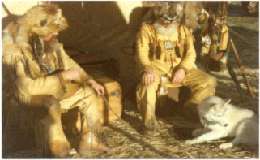
STAR AT RENDEZVOUS
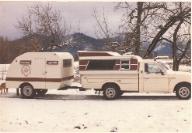

KIM'S
TRAILER FULL OF DOGS ON THE WAY TO THE
POW WOW 1970'S
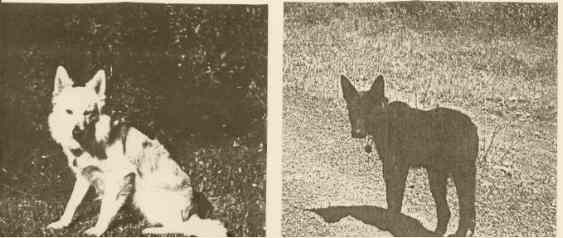
THESE
ARE EXAMPLES OF THE SLIGHT
DIFFERENCES OF DOG'S OF DIFFERENT REGIONS.
LEFT
IS COMBINATION OF PLAINS AND HARE
INDIAN DOGS.
RIGHT
IS OF SOUTHEASTERN
AND SOUTHWESTERN TYPES COMBINED. THESE
ARE ALSO DOGS IN THE FOUNDATION BREEDING.
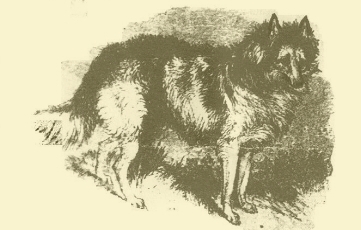
THIS
PICTURE, ALONG WITH ARTICLE, WAS SENT
TO KIM LA FLAMME FROM AN ANTHROPOLOGY
PROF. FROM FRANCE, WHERE HE FOUND, IN
AN OLD BOOK STORE. WRITTEN BY A FRENCH
EXPLORER FROM THE LATE 1700'S. DESCRIBES
THE HARE INDIAN DOG, WHICH SHOWS THE
CLOSE RESEMBLANCE OF ONE OF THE
FOUNDATION DOGS
ABOVE LEFT
AND THE ORIGINAL HARES.
Song Dog Kennels
3600 Lakeshore Drive
(541) 597-2871
email